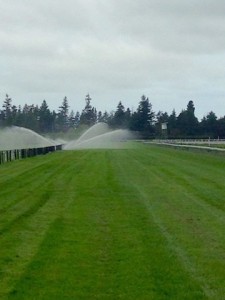


Ashburton Track Debacle
Fortuna Director John Galvin was at Ashburton on Saturday when the first cancelation occurred and with Jason Bridgman when the photo below was taken. The race meeting was rescheduled but then canceled again today. Why you may ask? Well, the comments below from David Ellis hit the nail right on the head
David Ellis comments on the Ashburton situation as follows:
“I have this to say about the Ashburton track –
There simply was not enough water put on the track in the last two weeks and with the wind that has been experienced, you can see quite clearly that the water wasn’t getting across the whole track. Jason took a photo of the irrigation working on Saturday after the races were called off and you can clearly see with the wind that the water wasn’t getting across the entire track.

The outcome of this is that you get the effect of having two or three metres of rock-hard surface which is absolutely not ideal. The track actually had a penetrometer reading of four once you came out into the middle of the track. Now a lot of people will say “what happens if you water the track and the rain comes?” – meaning that the track is then a six when it should ideally be somewhere between a three and a four. My answer to that is “yes okay it is a six but we are racing – not abandoning race days!”
Sometimes I think that our racing administrators have no idea just how expensive it is to have these cancellations – in our case we transported three horses from Riccarton to Ashburton. We had Jason Bridgman and Matthew Cameron who both flew from Auckland to Christchurch and then had to get cars to drive to Ashburton. Not forgetting a number of our owners who had also made the expensive trip to be on course to cheer their fillies on.
We are really relying on our clubs to deliver on a track that will sustain some rain.
In New Zealand racing generally speaking there are two groups of trainers – one is age group trainers and the other is trainers who specialise in training horses that in general terms do not do a lot of racing until they are four, five or six. To clarify where I am coming from, I guess you would say that Te Akau is an age group stable – we have horses in most of the major 2YO and 3YO races.
However there is the other group and you can think of a few who readily spring to mind – as trainers of mostly older horses – these trainers seldom have horses in major 2YO and 3YO races. Those types of older horses that they train are tough, dour types that can sustain rock-hard tracks in most cases.
However if 2YOs and 3YOs are going to get through the entire season of racing which is what the powers that be should be encouraging, they need to have a track with the give out of it. For example a 3YO today is meant to race at Hawkes Bay in October, run in the Guineas at Riccarton in November, be ready to back up for Christmas racing at Ellerslie in December/January and then hopefully get to the Derby or Oaks in March. Horses can only cope with this sort of preparation if the tracks have some give in them because the modern thoroughbred today simply jars up or goes shin-sore if the tracks are rock-hard. Whereas many older horses seem to be able to handle it.
So you have a situation where half the trainers want the track rock hard and half want the track with the jar out of it. I think the bottom line is that New Zealand Thoroughbred Racing policy should be that for summer racing, the Clubs prepare a track to provide for a reading of 4 for the morning of the races, that dries out by the middle of the card to a 3 – so a penetrometer of say between a 3 and a 4. This way if there is a shower on the day, tracks will sustain racing and the massive costs of commencing a race meeting and having one race before the fixture is abandoned does not keep occurring.
So to the trainers who are against watering I say – you need to look at the bigger picture and we can only avoid cancellations like Saturday by having good irrigation systems that cover the entire track.
The argument about what is best – age group racing versus older horses – is quite one-sided. In New Zealand it is just not financially viable to wait to assess horses until they are 4, 5 or 6YOs. The stake money in New Zealand is all around 2YO and 3YO racing. What I like most of all, is if you get a really good 3YO all the races they are in are at set weights so you don’t have to keep bleating on about whether the handicapper has done a good or bad thing for your horse – you just get on with it.
Of course the big money in New Zealand racing is in races like the NZB 1000 Guineas which has a stake of $300,000, the 2000 Guineas of $400,000, the Oaks which is $300,000 and the Derby which is $750,000 – those set weight races are what we are trying to win.”